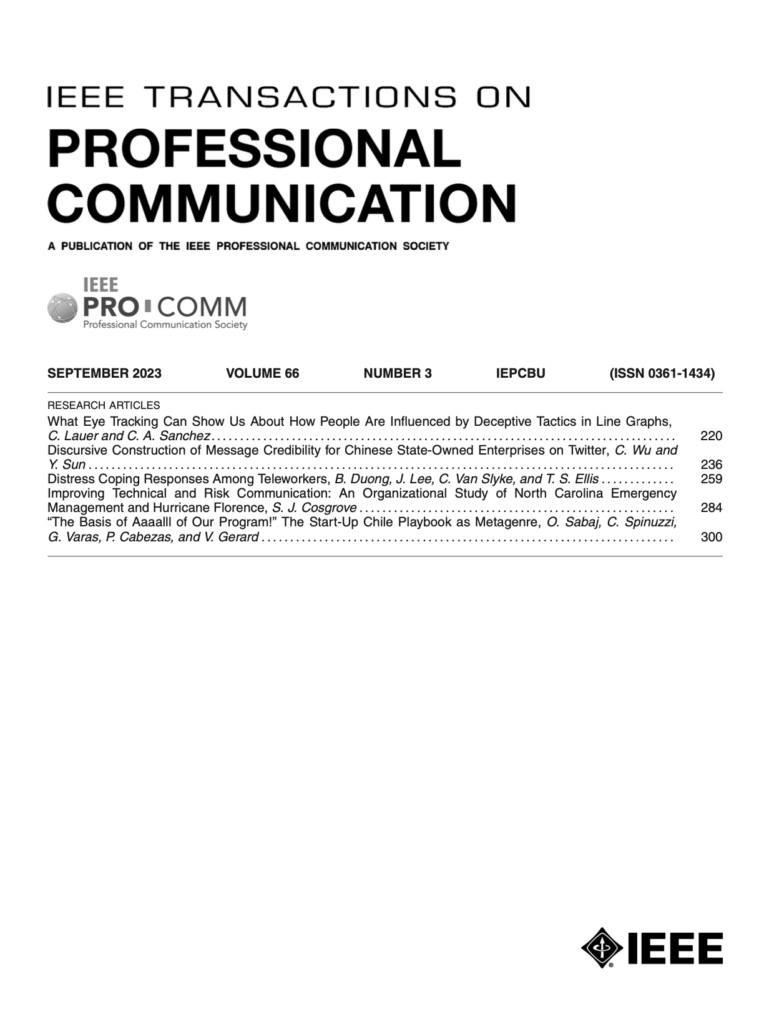The September 2023 issue of IEEE Transactions on Professional Communication is Now Available
Published on September 12, 2023
Volume 66, Number 3, September 2023

What Eye Tracking Can Show Us About How People Are Influenced by Deceptive Tactics in Line Graphs, Claire Lauer and Christopher A. Sanchez
Graphs, especially those that are generated automatically, are often subject to mistakes in their processing, framing, and construction, sending unintended messages that neither the viewer nor the author may realize. This study analyzed view time, fixations, revisits, and time to first fixation for the graph area, title, y-axis, and x-axis of four line graphs. Among other significant findings, this study found that participants spent significantly less time looking at both line graph axes for graphs with a rhetorically exaggerated title than those with a control title. Participants also fixated on and revisited deceptive graphs more so than control graphs, and fixated and revisited the title and x-axis of control graphs significantly more than deceptive graphs. It is critical to better understand how these changes influence viewing and how they might be leveraged to ultimately impact understanding.
Discursive Construction of Message Credibility for Chinese State-owned Enterprises on Twitter, Chenghui Wu and Ya Sun
There is a growing need for Chinese state-owned enterprises (CSOEs) to utilize Twitter, as an effective communicative tool in the professional business context, to build a credible image to the global community. Little attention has been paid to measuring the discursive construction of message credibility through corporate Twitter. We collected tweets during the year 2020 from the official Twitter accounts of 15 CSOEs and applied our operationalized framework to conduct nine separate One-way ANOVAs, a principal component analysis (PCA) and a mean-value based descriptive statistics comparison respectively. First, CSOEs developed themes and used discursive features including nominalizations, mentions/@, word length, time adverbials, hashtags/#, and semantic overlaps, among others when expressing these themes to establish message credibility. Second, CSOEs significantly highlighted the <capability>, <authority>, <informativeness>, and <consistency> dimensions of message credibility in their tweets. Last, China National Machinery Industry Co. (Sinomach), China Datang Co. (CDC), China Railway Engineering Co. (CREC), and China State Construction Engineering Co. (CSCEC) were found to have established the highest message credibility in their tweets.
Distress Coping Responses among Teleworkers, Bao Duong, Jaeung Lee, Craig Van Slyke, and T. Selwyn Ellis
Data from a survey of 504 American teleworkers were used to test the humanistic effects of telework. Results suggest that teleworkers cope with telework distress through assistance seeking, technology experimentation, venting, and negative and positive emotions. Coping responses had differential effects on telework exhaustion and satisfaction, with negative and positive emotions and venting affecting exhaustion, and assistance seeking, task experimentation, emotions, and venting affecting satisfaction. Distress had a direct effect on exhaustion, but not on satisfaction. The effects of emotion-focused coping on telework satisfaction and exhaustion are notably stronger than those of problem-focused coping responses. Emotion-focused coping responses that are adaptive have beneficial effects, while those that are maladaptive have detrimental effects. Adaptive problem-focused responses have similar effects. The extent of communication focus does not seem to affect the impact of coping responses on outcomes.
Improving Technical and Risk Communication: An Organizational Study of North Carolina Emergency Management and Hurricane Florence, Samantha Jo Cosgrove
This article uses Clay Spinuzzi’s topsight concept as a framework to conduct an organizational analysis of North Carolina Emergency Management (NCEM) response to Hurricane Florence in 2018. Interviews were conducted and artifacts were collected to investigate three levels of activity and create corresponding workflow diagrams. Results indicate a need for standardized emergency management training and additional resources to support emergency managers. Findings indicated that interventions from technical and professional communicators could assist in developing communication strategies and problem-solving techniques. Developing informed communication strategies within an emergency management agency is a complex problem because of the numerous factors that play into the organizational structure and existing protocols. Technical communication scholars can help improve communication practices through local community outreach and additional organizational analyses.
“The Basis of Aaaalll of Our Program!” The Start-Up Chile Playbook as Metagenre, Omar Sabaj, Clay Spinuzzi, Germán Varas, Paula Cabezas, and Valentin Gerard
Following previous professional communication research into entrepreneurship, we examine key genres of a specific business accelerator, Start-Up Chile (SUP). Through a triangulated study of interviews, texts, and videos, we examine how the Playbook serves as a regulatory metagenre that represents the SUP experience to the participating firms. We find that aspects of the Playbook’s representation are at odds with the other data, divergences that we argue emerge from a broader tension among SUP’s stakeholders and goals. We review the professional communication literature on entrepreneurship, literature on startups and accelerators, and on writing, activity, and genre research (WAGR). Specifically, we examine WAGR research on metagenres and professional identity formation. We structured this research as a qualitative case study of SUP. We conclude by discussing implications for accelerators as well as for how professional communication genres and metagenres regulate neophytes’ experiences in training programs more broadly.

